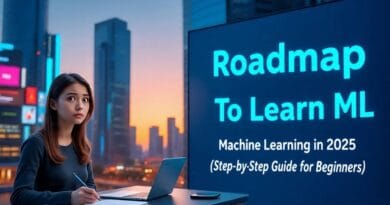How to Learn AI in 2025 (Step-by-Step Guide for Beginners)
Artificial Intelligence is changing the world rapidly, and if you’re planning to step into this powerful field in 2025, there’s never been a better time. But where do you begin? How do you avoid confusion and stay on the right path?
This post will walk you through a clear, structured roadmap to learn AI from scratch—even if you have zero experience.
1. Start With the Basics: Mathematics
Before diving into algorithms or coding, you need to build your foundation in mathematics—because math is the language of AI.
Key areas to focus on:
- Linear Algebra: Essential for understanding vectors, matrices, and operations used in models.
- Calculus: Learn differentiation and integration—not for exams, but to grasp how models change and optimize.
- Probability: Understand random events and outcomes. Concepts from probability theory are critical in model evaluation and predictions.
Don’t rush. Focus on understanding concepts, not solving fast like school exams.
2. Learn Python Programming
To create AI models, you need a language your computer understands. That’s Python—the go-to language in AI and machine learning.
Learn:
- Data types, conditionals, loops
- Functions and how to write reusable code
- Object-Oriented Programming: Classes and objects
Once you’re confident writing small programs, you’re ready for the next step.
3. Master Data Science Tools
AI thrives on data, and data science teaches you how to prepare and understand it.
Start with three essential Python libraries:
- NumPy: For working with arrays and performing complex mathematical operations.
- Pandas: For manipulating and analyzing data in rows and columns.
- Matplotlib: For visualizing data through charts and graphs (bar charts, line graphs, pie charts, etc.).
👉 Tip: FreeCodeCamp offers a free masterclass on these tools. Also, explore datasets and challenges on Kaggle to practice.
4. Understand Machine Learning (ML)
Now that you can handle data, it’s time to move into the core of AI: Machine Learning.
What is Machine Learning?
It’s the art of building systems that learn from data. You feed in input and output, and the system learns to map input to output using algorithms.
Types of ML:
- Supervised Learning: You train with labeled data.
- Unsupervised Learning: You train with unlabeled data.
- Reinforcement Learning: The model learns by receiving rewards or penalties based on its actions.
5. Supervised Learning: Prediction & Classification
Common Algorithms:
- Linear Regression: Predict continuous values like house prices.
- Logistic Regression: For binary classification (spam vs. not spam).
- K-Nearest Neighbors (KNN): Classifies based on the closest data points.
- Support Vector Machines (SVM): Separates data using hyperplanes.
- Decision Trees: Breaks decisions down into tree-like structures.
- Random Forest: Combines many decision trees for better accuracy.
- Naive Bayes: Based on probabilities; great for text classification like spam detection.
6. Unsupervised Learning: Clustering
When your data has no labels, you rely on unsupervised learning.
Key Technique:
- K-Means Clustering: Groups data into categories based on similarity. Useful in user segmentation, recommendation systems, and market research.
7. Reinforcement Learning: Learning by Trial and Error
In Reinforcement Learning, an agent learns by interacting with an environment and optimizing for rewards.
Example: Teaching an AI character in a game to reach a goal. Each correct move earns points; wrong moves lose points.
This method powers robotics, autonomous vehicles, and even financial trading bots.
8. Deep Learning & Neural Networks
Neural networks mimic the human brain using layers of neurons.
- Input Layer: Receives data.
- Hidden Layers: Transform the data using weights, biases, and activation functions.
- Output Layer: Gives predictions.
These networks improve through backpropagation—learning from mistakes and adjusting parameters.
Applications:
- Handwriting recognition
- Image and voice classification
- Fraud detection
- Self-driving cars
9. Advanced Neural Networks
- Convolutional Neural Networks (CNNs): Best for image-related tasks.
- Recurrent Neural Networks (RNNs): Great for text, speech, and sequences.
- Feedforward Neural Networks: Basic version where data flows in one direction only.
10. Generative AI: The Frontier of AI in 2025
Welcome to the age of Generative AI. This is where AI doesn’t just analyze—it creates.
Two Major Types:
- Diffusion Models: Used in image generation (e.g., DALL·E).
- Large Language Models (LLMs): Like ChatGPT.
LLMs are based on transformers, a type of neural network that predicts the next word in a sentence. They use a concept called attention to decide which words in the context are most important.
Key Concepts:
- Parameters: The “brain cells” of the model. The more parameters, the smarter it can become.
- Reinforcement Learning from Human Feedback (RLHF): Humans teach the model which answers are better.
Want to dive deeper? Watch:
- Three Blue One Brown’s video on transformers
- Andrej Karpathy’s series on building with LLMs
Bonus: Free Learning Resources
🎁 As promised, here are some amazing free resources to begin your AI journey:
- FreeCodeCamp – Python, Data Science, Machine Learning
- CS50’s AI Course – Deep understanding of ML, RL, and more
- Kaggle – Real-world datasets and projects
- HubSpot’s Free AI Resources – Tools for generative AI
Final Thoughts
Learning AI in 2025 doesn’t require a PhD—it requires curiosity, commitment, and the right resources.
Start small. Master the basics. Build projects. Tinker. Make mistakes. Try again.
Soon, you’ll not just use AI—you’ll create it.
Have questions or suggestions? Leave a comment below and let’s discuss!




